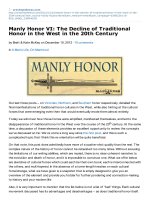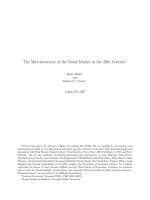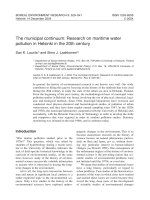307721056 20th century jazz guitar richie zellon
Bạn đang xem bản rút gọn của tài liệu. Xem và tải ngay bản đầy đủ của tài liệu tại đây (10.66 MB, 114 trang )
20th Century
JAZZ
GUITAR
“Selected Phrases By Its Most Influential Artists”
Richie Zellon
This Book Is Strictly For Educational Purposes. Its Sale is Prohibited.
About This Book
This book is a compilation of short phrases I transcribed during a period of several years to complement and aid in the education of my jazz guitar students. In
doing so, I chose to represent only 16 influential soloists in the history of jazz
guitar, from its inception in the early 20th century up until its close. As a result,
several artists who did not garner the recognition required to become “household” names in the world of mainstream jazz guitar, have not been featured here.
Doing so would defeat the initial purpose of this collection which is to provide
brief samples of each stylistic era within the evolution of jazz guitar. Sad to say,
among those left out are some of my personal favorites! Others who were not
recorded extensively, but are known to have influenced some of the better known
players of their era, have also been omitted. To name a few- from the Swing Era:
Eddie Lang, Carl Kress, Freddie Green (not a soloist), Oscar Aleman, George Barnes,
George VanEps, Bucky Pizzarelli; from the Bebop Era: Oscar Moore, Tiny Grimes,
Bill DeArango, Billy Bauer, Billy Bean, Chuck Wayne, Joe Puma, Sal Salvador, Herb
Ellis, Johnny Smith, Barry Galbraith, Howard Roberts; from the Post-Bop Era:
Attila Zoller, Joe Diorio, Ralph Towner, Lenny Breau, Ed Bickert, & Mick Goodrick.
Although the outline of stylistic eras in this book includes the Fusion Era, I have
not included transcriptions of several of its leading proponents, due to the fact
that my goal has been to concentrate on mainstream jazz guitar. In spite of this,
I believe the following fusion players deserve a mention here, as they have delved
into uncharted territory on the guitar and have opened up new possibilities at the
creative and technical level: John McLaughlin, Larry Coryell, Allan Holdsworth, Al
Dimeola & Frank Gambale. Last but not least, I feel indebted to name some of the
leading players in the Gypsy Swing revival that began towards the closing of the
20th century: Bireli Lagrene, Bolou Ferre & Stochelo Rosenberg.
The inclusion of each player’s profile and selected discography, was an afterthought to the transcriptions and is not intended to be the primary focus of
this book. However, I felt this would provide my new jazz guitar students with
some brief historical background regarding each artist. Even though most of this
information is readily available throughout the internet, for those desiring a more
detailed account into the life of each player, I recommend the well researched
book by Scott Yanow,“The Great Jazz Guitarists: The Ultimate Guide”.
To conclude, I would like to share with those guitarists who are new to the art of
jazz improvisation, some thoughts regarding the study of the transcriptions herein. Let me begin by saying that jazz is a language with a unique grammar, somewhat functionally similar to that of a non musical language. To fluently converse
in it, we must be in the moment and interact, both with our surrounding musicians as well as our immediate audience. Furthermore, to be understood by its
native practitioners we must first become familiar with the idiomatic phrases
4
that make up its vocabulary. That said, we will never properly learn to improvise fluently by merely playing the phrases included in this book, outside of the
harmonic and thematic context they were originally played in. These phrases
were not performed as memorized licks or riffs by their executioners—they were
extracted from a cohesive unit of melodic ideas, spontaneously woven into a solo
over a given set of chord changes. This in turn is the result of each performer having spent years studying the construction of jazz lines from their predecessors,
and perfecting the technical resources required to play them!
This collection of phrases is meant to provide the student with a glimpse into
the creative mind of each artist when analyzing the melodic composition of his
lines. In doing so the aspiring improviser will gain knowledge as to how a master
player combines a set of harmonic resources (eg. scales, arpeggios) to create his
vocabulary. To facilitate this, each transcription has been identified by cadence
(eg. II-V). Consequently, in order to derive improvisational vocabulary modeled
after a transcription, a working knowledge of harmonic and melodic analysis is
required on behalf of the student. The lack thereof, will otherwise lead to the
memorization of a phrase that has no continuity in a solo; versus the spontaneous
construction of that which seamlessly fits into the context of the given harmony.
If you are among those guitarists seeking a thorough understanding of how to
construct jazz lines versus playing memorized licks when improvising, I want
to take this opportunity to introduce you to the Bebop Guitar Improv Series.
This is a comprehensive 1 year e-course consisting of 150+ hd videos which will
take you from the ground up through all the rudiments of jazz improvisation. It
is exclusively guitar oriented and all the lessons include both regular notation as
well as tablature. In addition, you will benefit from an information filled forum
through which I will personally answer all your jazz guitar related questions. This
and much, much more is available at an incredibly low price! For more information please visit:
/>Last but not least, please be informed that I have personally played and demonstrated most of the transcriptions featured in this book on a series of videos which
have been posted on “The Jazz Guitar Channel” on YouTube.
Thanks for downloading this free e-book. Enjoy!
Richie Zellon
5
About The Author
Richie Zellon, guitarist, composer,
and music educator, has held teaching positions as professor of jazz guitar at Florida International University
(Miami) the University of South Florida (Tampa) The Music Workshop
(Orlando) and his own venue, Miami
Jazz Guitar.
With several critically acclaimed
recordings under his name, Zellon has
recorded and performed with some of
the most influential musicians both in the mainstream and Latin jazz genres.
Among them, Paquito D’ Rivera, David Leibman, Jerry Bergonzi, Sam Rivers,
George Garzone, Danilo Perez, Edward Simon, Jeff Berlin, Abraham Laboriel,
Oscar Stagnaro, Alex Acuna and Ignacio Berroa to name a few.
Due to his innovations in the field of jazz and latin music he has been profiled
in several important books such as “The Great Jazz Guitarists” by Scott Yanow,
“The Jazz Guitar: Its Evolution, Players and Personalities Since 1900” by Maurice J. Summerfield, “El Diccionario de Latin Jazz” by Nat Chediak, “Caliente:
A History of Latin Jazz” by Luc Delanoy and “Jazz Jews” by Michael Gerber.
For almost a decade, he wrote an instructional column for Jazz Improv magazine. In addition to his dedication to mainstream jazz, his ongoing research on
the music of various Latin American cultures and their fusion with contemporary music has been a sought after topic by musicians at international clinics
and workshops as well.
For more information please visit www.richiezellon.com
6
Contents
The Styles
The Swing Era.................................................................... 9
The Bebop Era....................................................................10
The Cool Era.......................................................................11
The Hard Bop Era.............................................................. 12
The Post Bop Era............................................................... 13
The Fusion Era................................................................... 14
The Players
Django Reinhardt............................................................... 16
Charlie Christian................................................................. 22
Barney Kessel ................................................................... 27
Tal Farlow.......................................................................... 34
Kenny Burrell..................................................................... 39
Jimmy Raney..................................................................... 46
Wes Montgomery............................................................. 51
Joe Pass............................................................................ 60
Grant Green....................................................................... 68
George Benson.................................................................. 73
Pat Martino........................................................................ 79
Jim Hall.............................................................................. 86
Pat Metheny...................................................................... 94
John Scofield................................................................... 100
John Abercrombie............................................................106
Mike Stern........................................................................ 111
7
The
Styles
Brief Synopsis of the Stylistic Evolution of Jazz
The guitar first played an important role in Blues and Dixieland
prior to the 1930’s. However, it wasn’t until after this period in
time that the guitar began developing its own sophisticated
voice and was first featured in jazz improvisation at par with the
piano, brass and woodwind soloists. In lieu of this fact, I have
chosen to begin this synopsis of the evolution of jazz, with the
Swing Era.
8
The Swing Era
(1930’s)
The Swing Era’s most prominent contribution to jazz is believed
to be by many, the introduction of the “big band” orchestra
format. In addition to a combination of brass, woodwinds, and a
rhythm section, until the 1930’s most dance orchestras also
included a string section. The string instruments were dropped
from the format and the new orchestras were streamlined for
the new daring swing arrangements which featured not only
highly orchestrated music influenced by European traditions, but
also a soloist who after taking center stage, would improvise
over the framework of the entire piece. It was not unusual for
other soloists to join in sometimes and engage in collective
improvisation, a practice already common when performing
Blues and Dixieland.
9
The Bebop Era
(1940’s)
Most Jazz historians agree that the foremost architects of the
Bebop era were trumpeter Dizzy Gillespie, saxophonist Charlie
Parker and pianist Thelonious Monk. Along with bassist Milt
Hinton, and drummer Kenny Clarke, the quintet began jamming
informally at “Mintons Playhouse” (Harlem, NY.) in 1941. Due to
a fight between the American Federation of Musicians and the
record labels, a two year ban took place on all recordings thus
not allowing this new jazz idiom to be documented on record
until 1944.
Bebop musicians experimented with various sophisticated concepts of improvisation, harmonic substitutions, polyrhythms and
developed a higher degree of interaction between the soloist
and the rhythm section. In doing so they set the foundation for
jazz improvisation as we know it today. Unlike the soloists of the
Swing Era, when improvising they were not bound (swayed) by
the main melody of the piece. As a matter of fact, many Bebop
originals were created as the result of an improvised solo played
over the chord progression of a familiar standard (e.g. Parkers
“Anthropology” & “Dexterity” are based on “I Got Rhythm”,
“Ornithology” is based on “How high the Moon”, “Donna Lee”
is based on “Indiana” and Bud Powell’s “Hot House” is based on
“What is this thing called Love”)
By mid World War II, Bebop began to be embraced by many jazz
musicians as their preferred idiom. As a result jazz was transferred from the dancehall back to the small club and likewise
from the big band to the small combo. Jazz was no longer music
for the masses and its popularity was never recovered from
that day on. As the music moved away from big business, it
became an art form reserved for a niche of musicians and jazz
connoisseurs forcing the major labels to explore other markets
for their source of profit. This gave rise to several small independent jazz labels such as Blue Note, Prestige and Savoy, who
specialized in catering to that loyal minority of followers that has
kept the music alive to the present day.
10
The Cool Era
(1950’s)
The Cool Jazz sound evolved in the early 1950’s as a result of
the influx of new white musicians entering the jazz scene and
mixing with the predominantly black bebop musicians. This
gave rise to a less aggressive sound and introduced new instrumental textures as well as compositions and arrangements that
drew several elements from 20th century European music.
Miles Davis became a major influence with his 1950 ground
breaking recording entitled “Birth of The Cool”, featuring a nonet
with arrangements by Gil Evans. This era heralded Davis’s
relaxed style of soloing, emphasizing the use of space.
The Cool Jazz era is also synonymous with a new movement
that developed in the West Coast and introduced other important musicians such as Gerry Mulligan, Chet Baker, Lee Konitz,
Paul Desmond and Dave Brubeck who made his mark with his
now classic “Take Five” recording.
11
The Hard Bop Era
(Mid 1950’s)
By the mid fifties bebop had declined and many young jazz
musicians were listening to rhythm and blues. As a result its
influence started being heard in their compositions as well as
improvisations. This new sound became known as Hard Bop
and its birth is marked by several recordings released in 1954
primarily featuring Art Blakey and the Jazz Messengers, Horace
Silver, Miles Davis and Clifford Brown. These musicians all knew
that the only way to get the jazz audience back and be successful again was to make music that was memorable. Therefore
the complex bebop compositions in the style of Charlie Parker
and Dizzy Gillespie were replaced by simpler more “groove oriented” melodies that universal audiences could relate to easier.
12
The Post Bop Era
(Late 1950’s)
During the early 1960’s, the jazz movement took simultaneous
new directions as both new and established musicians experimented with different harmonic and rhythmic approaches in
their music. A handful of players, in the interest of having no
harmonic restrictions when improvising, pioneered the so called
“free jazz” or “avant garde” movement which consisted of atonality and no formal structure. Among them Ornette Coleman,
Cecil Taylor, Albert Ayler, Sun Ra, etc. The remaining majority of
musicians took the existing swing and bebop elements to the next
level and helped develop what is often referred to as post bop.
At the forefront of the post bop movement was saxophonist
John Coltrane, who along with former employer Miles Davis,
explored within their respective combos new harmonic and
rhythmic concepts such as modalism and impressionism. Other
musicians who were influential in shaping the direction of jazz
during this period were Wayne Shorter, Herbie Hancock, Bill
Evans, McCoy Tyner, Charles Mingus, Joe Henderson, etc. Much
of the music which defined the post bop sound was recorded on
Blue Note records.
Post bop has become the norm for mainstream jazz as it is
played by musicians today!
13
The Fusion Era
(1960’s)
With the popularity of rock in the 1960’s, the latter part of this
decade gave rise to a new development among jazz musicians
known as fusion, also referred to as “jazz rock”. Music critic Piero
Scaruffi claims that “credit for ‘inventing’ jazz-rock goes to Indiana-born jazz vibraphonist Gary Burton, who “began to experiment with rock rhythms on The Time Machine (1966)”. Burton
recorded what Scaruffi calls “the first jazz-rock album, Duster” in
1967, with guitarist Larry Coryell.
Once again trumpeter and composer Miles Davis had a major
influence on the development of fusion as he started introducing
electric instruments and rock grooves within his recordings in
1968. His seminal recordings of “In a Silent Way” (1969) and
“Bitches Brew” (1970) featured a host of musicians who were
influential in the development of jazz fusion throughout the
1970’s. Among them guitarist John McLaughlin with the Mahavishnu Orchestra, Chick Corea with Return To Forever, Joe Zawinul
and Wayne Shorter with Weather Report, Herbie Hancock with
The Headhunters and Tony Williams with his power trio, Lifetime.
14
The
Players
15
Django Reinhardt
SWING
DJANGO REINHARDT SELECTED DISCOGRAPHY:
1945 Paris 1945
1947 Ellingtonia – with the Rex Stewart Band
1949 Djangology
1951 Django Reinhardt and the Hot Club Quintet
1951 At Club St. Germain
1953 Django Reinhardt et Ses Rythmes
1954 The Great Artistry of Django Reinhardt
1955 Django’s Guitar
1959 Django Reinhardt and His Rhythm
1980 Routes to Django Reinhardt
1996 Imagine
2001 All Star Sessions
2001 Jazz in Paris: Swing 39
2002 Djangology (remastered 1948)
2003 Jazz in Paris: Nuages
2003 Jazz in Paris: Nuits de Saint-Germain des-Prés
2004 Le Génie Vagabond
2008 Django on the Radio (radio broadcasts,
1945 – 1953)
* Many of these are available under newly released
compilations
VIDEOS:
Django Reinhardt:King of Jazz Guitar (DVD)
Swing Guitar: The Genius of Django
Reinhardt (DVD)
16
During the 1930’s in Europe an important movement known as “Gypsy Swing “surfaced among
jazz aficionados. It was inspired by Belgium born
guitarist, Jean “Django” Reinhardt. Also known
as “manouche jazz”, its orchestration consisted
of guitar (usually 2), violin, accordion, clarinet
and upright bass. The percussive nature of the
drums was replaced by a rhythm guitar technique known as “la pompe”. Another peculiar
characteristic of this style is the use of mainly 2
and 3 finger chord structures instead of standard
barre chords on guitar. This is to emulate the
unique style Django Reinhardt developed in
order to play chords as a result of a hand injury.
At the age of 18, Reinhardt’s caravan caught on
fire and two of his left hands fingers were badly
burned. Although he was able to relearn how to
execute his single string solos at blazing tempos
with only 2 fingers, his remaining digits were
reserved for a limited physical role in the formation of chords. As a result Django’s chords consisted of only the essential notes. What a coincidence that around this same period in time,
thousands of miles away, guitarist Freddie Green
developed a very similar harmonic concept
except for different reasons!
In 1934, Reinhardt and Parisian violinist Stéphane
Grappelli formed the “Quintette du Hot Club de
France”.The guitars used by Django and the Hot
Club of France, the Selmer Maccaferri, are the
first commercially available guitars with a cutaway. This was the first time a steel reinforced
neck was employed. Many luthiers consider them
to be among the finest guitars ever made.
Django Reinhardt died on May 16, 1953 in Fountainbleu, France of a brain hemorrhage. Contemporary Gypsy jazz is kept alive today thanks to
many guitarists such as Bireli Lagrene, Boulou
and Elios Ferre,Babik Reinhardt, Angelo DeBarre,
Stochelo Rosenberg, and John Jorgensen among
many others.
From
“Embracable You”
(1946 Version)
Transcribed by Richie Zellon
3
T
A
B
3
17
From “Embracable
You”
(1946 Version)
Transcribed
by Richie Zellon
3
3
T
A
B
From “Embracable
You”
(1946 Version)
Transcribed
by Richie Zellon
3
3
T
A
B
18
From “Daphne”
(1949 Version)
Transcribed
by Richie Zellon
3
33
3
T
A
T
B
A
B
3
3
3
3
19
From “Daphne”
(1949 Version)
Transcribed by Richie Zellon
3
3
T
A
B
T
A
B
20
3
3
T
T
A
A
B
B
From “All of Me”
(1940 Version)
Transcribed by Richie
Zellon
3
3
3
3
21
Christian was born in Bonham, Texas, on July
29th, 1919, and raised in Oklahoma City. It was
here that Christian learned to play guitar as a
kid. As a result of his surroundings he was
influenced not only by jazz and blues but also
by country music. This hybrid amalgam of influences is evident when listening to several of
his recordings such as “Seven Come Eleven,”
with the Benny Goodman Sextet. Christian
admitted to wanting to sound like a tenor saxophone and thus his fluent horn-like solos
were influenced by saxophonists such as
Lester Young .
Charlie Christian
SWING
Throughout the first part of the 20th century,
jazz was not considered a respectable form of
music among mainstream white audiences
due to the fact that it was synonymous with
the music of brothels and black culture. However, in 1930 George Gershwin was responsible for completing the assimilation of jazz into
white American society by writing I Got Rhythm
for a successful Broadway musical. One of the
musicians who played in the pit orchestra of
that show was a young clarinetist named Benny
Goodman who went on to become one of the
most influential band leaders of the swing era.
Until this point most bandleaders associated
with jazz, were black. Not only has Benny
Goodman been credited for being one of the
first white bandleaders in the world of jazz
(along with Glen Miller and the Dorsey brothers) but also for introducing us to Charlie Christian, one of the first electric guitarists in the
history of jazz improvisation.
22
While working in Oklahoma as a young musician, Christian was able to jam with several big
name musicians who came through town such
as Teddy Wilson and Art Tatum. It was pianist
Mary Lou Williams who first gave word to
record producer John Hammond about the talented young guitarist. After auditioning Christian, Hammond arranged a meeting with Benny
Goodman. Being the first white bandleader to
feature black musicians, in 1939 Goodman
hired Charlie Christian to play in his newly
formed sextet also featuring Lionel Hampton
on vibraphone and Teddy Wilson on piano.
Shortly thereafter, Christian’s innovative style
on guitar was captured in the studio for the first
time. Unfortunately, his recording career lasted
less than two years, as he died of tuberculosis
on March 2, 1942, in New York.
CHARLIE CHRISTIAN SELECTED DISCOGRAPHY:
Solo Flight
VIDEOS:
Solo Flight: The Genius Of Charlie Christian
DVD
Charlie Christian –The Life And Music Of The
Legendary Jazz Guitarist DVD
From “Grand Slam”
Measures
9 - 12 of Solo
Recording: “Solo Flight”
Transcribed by Richie Zellon
T
A
B
23
T
A
B
24
From “Seven
Come Eleven”
First 2 Measures
of Bridge
Recording:“Solo
Flight”
Transcribed by Richie Zellon
T
A
B
From “Solo
Flight”
Last 2
Measures of solo
Recording:
“Solo Flight”
Transcribed
by Richie Zellon
25









